Forts and palaces of India
This page lists a sample of the hundreds of (if not over a thousand) forts and palaces in India. This is not a comprehensive list – it represents only some of the important historic forts and palaces.
These samples are diverse in architectural structure and representative of India's rich and long history. Some early designs were to build with extremely thick stone or brick walls with reinforced gates to protect against elephants, others with more delicate touches, and later modern forts have a distinct European flavor. Early towns and cities began and grew around forts.
Some palaces were built as forts, and many palaces (and religious temples) were built within the walls of forts. Some palaces owe their survival to having become heritage hotels. Museums are usually found at or near these sites.
Entries marked with the symbol ![]()
Forts of India
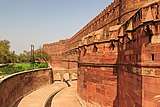

- 🌍
Agra Fort, Agra. This fort; primarily built with red sandstone, is similar in design to the Red Fort in Delhi The Taj Mahal can be seen from here.

- 🌍 Aguada Fort, Bardez Taluka, Goa. Aquada Fort was constructed by the colonial Portuguese as a defense against the Dutch and Marathas. This important Portuguese fort is situated on the beach south of Candolim near the Mandovi River.
- 🌍
Amer Fort (Amber Fort or Amer Palace), Jaipur. Amber fort is located in Amber near Jaipur. It is a massive fort-palace complex built in the Hindu-Muslim style dating back to Raja Man Singh and former royal palace of the Kachwahas. Within the fort is the Sheesh Mahal (with thousands of mirror tiles on the walls and ceilings)

- 🌍 Bahu Fort, Jammu. Bahu Fort was constructed on a rock face (bank of the Tawi river). It has many gardens (Bagh-E-Bahu) surrounding it.
- 🌍 Bathinda Fort (Qila Mubarak), Bathinda. Qila Mubarak was once the official residence of the Maharaja. The complex has many courtyards and structures. Among these are the Qila Androon, the main entrance gate, Sheesh Mahal (palace of mirrors) , Raan Baas with its frescoes frescoes and Durbar Hall (containing weapons/arms).
- 🌍 Bidar Fort, Bidar. Located on the Deccan plateau, the strong Bidar Fort still remains impressive even though it has suffered neglect and age.
- 🌍
Chittaurgarh Fort (Chittorgarh Fort), Chittorgarh. Chittorgarh Fort in Chittorgarh has massive stone gates with notched parapets and arched reinforced doors (to defend against elephants and cannon). Within the fort a circular road gives access to the gates and numerous monuments (ruined palaces and many temples)

- 🌍 Daulatabad Fort (Deviagiri Daulatabad Fort), Aurangabad. Daulatabd Fort (12th century) was built on top of a hill. This sturdy fortress has strong walls and ramparts. Nearby is a the bat cave.

- 🌍
Fatehpur Sikri, Agra. Fatehpur Sikri (City of Victory) is a virtual ghost town near Agra. Built by the Emperor Akbar, it was the capital of the Mughal Empire and later abandoned as local water supplies were diminished and proximity to the rival Rajputana areas in the North-West. It includes one of the largest mosques (Jama Masjid) in India. The are contains well maintained palaces and courtyards.

- 🌍 Fort William, Kolkata. Fort William (after William III),is built of brick and mortar in an irregular octagon shape. There are six gates and is similar to other forts of this period (Thalassery fort). Access may be limited as Indian Army HQ is located here.
- 🌍
Gagron Fort, Jhalawar. Gagron Fort located in Jhalawar is an example of a hill and water fort. Kali Sindh & Ahu Rivers border the fort on three sides. Gagron Fort (also known as Galkangiri) was built by King Bijaldev (Parmara Empire).

- 🌍 Golconda Fort, Hyderabad. The Golconda Fort was the capital of the Qutb Shahi kingdom.
- 🌍 Gwalior Fort, Gwalior. The Golconda Fort was the capital of the Qutb Shahi kingdom. The outer wall is extensive (circa 10km). This famous fort has a rich history.
- 🌍 Hari Parbat Fort (in Kashmir valley Srinagar near Jammu). Hari Parbat is a Mughal fort located on Sharika Hill near the Dal Lake in Srinagar.

- 🌍 Jaigarh Fort, Jaipur. Jaigarh Fort was considered the strongest of the three forts in the area. It is known for the world's biggest cannon (the Jaivana). There are scenic gardens and has wonderful views of the Amber Fort and the surrounding area.
- 🌍
Jaisalmer Fort, Jaisalmer. Jaisalmer Fort ( known as the “Sonar Quila” or "Sonal Kella" or "Sonar Kila") in Jaisalmer displays the subtle hues of the setting sun and desert. It is a 'working fort' as its citizens reside and work within its walls. There are numerous advantage points within the fort that enable great views across the city and desert.

- 🌍 Jhansi Fort, Jhansi, Manjeshwar. A hilltop fortress of the Maratha kings was built above Shankargarh town. This massive fort exists in good shape to this day.
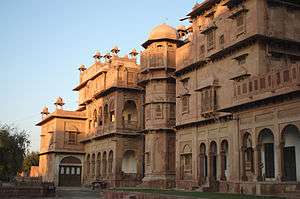
- 🌍 Junagarh Fort (Bikaner Fort), Bikaner. Built by Raja Rai Singh is a fort of the Bikaner royal family. It has a rich history as well as a museum which contains weapons, ornaments and artifacts of the period. It is one of the oldest forts in India.
- 🌍 Kangra Nagarkot Fort (Kangra Fort), Kangra. Built by the royal Rajput family of Kangra State. It is the largest fort in the Himalayas. This is found in a very scenic area.
- 🌍
Kumbhalgarh Fort, Kumbhalgarh (34 km from Pune near). Kumbhalgarh Fort (fortress) in Kumbhalgarh is protected by seven towering gates and within its walls is the Badal Mahal palace. It had long meandering walls for defense. There are many tales and stories are associated with this site.

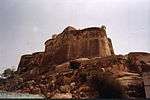
- 🌍 Laxmangarh Fort, Laxmangarh, Rajasthan. The Laxmangarh Fort was built by the Raja of Sikar. The use of rocks in constructing the fort of Laxmangarh makes its architecture unique.
- 🌍 Lohagad Fort (Iron Fort), Maharashtra (34 km from Pune near Lonavala hill station). One of many hill forts of Maharashtra. Lohagad Fort is a protected monument.
- 🌍 Lohagarh Fort (Iron Fort), Bharatpur. Lohagarh Fort was one of the strongest forts built in India. Within are monuments and towers (most notably the Victory Tower Fateh Burj).
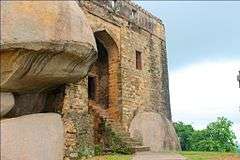
- 🌍 Madan Mahal Fort, Jabalpur. A small (compact) fort in Jabalpur has a stable, a reservoir, several rooms and chambers. The famous Balancing Rock (natural wonder of India) is nearby.
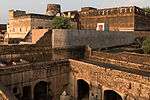
- 🌍 Mandawa Fort, Mandawa, Rajasthan. Mandawa Fort (and palace) was built by Thakur Nawal Singh. It is adorned with frescoes and paintings. Durbar Hall houses antiques and paintings. It was converted into a heritage hotel.
- 🌍 Mehrangarh Fort, Jodhpur. The large Mehrangarh Fort overlooks Jodhpur, Rajasthan. It is the site of Rao Jodha's new capital. The city of Jodhpur virtually grew around this fort. It has massive ramparts built it and provides an excellent view of the area. There are several palaces, a museum and preserved canon (the famous Kilkila) within.

- 🌍 Murud-Janjira Fort, Murud. Murud-Janjira is a fort on an island near the village of Murud, in Maharashtra.
- 🌍 Nagaur Fort (Ahhichatragarh or Fort of the Hooded Cobra), Nagaur. Nagaur Fort; a former Moslem fortress in Northern India, has many rennovated fountains, gardens and buildings.
- 🌍 Nahargarh Fort, Jaipur. A small fort in Jaipur with views over Man Sagar lake and the city of Jaipur. Built by the Maharaja Sawai Jai Singh II, it is a mix of Indian and European influence. Within the fort is the Madhavendra Bhawan palace.
- 🌍 Old Fort, Rajpura. Rajpura (Old Town) grew from within this Fort.
- 🌍 Panhala Fort, Kolhapur. Panhala Fort has a rich heritage and is the largest of all the Deccan forts. Ambabai Temple is located here where Shivaji sought blessings before his ventures.

- 🌍 Purana Quila (Old Fort), Delhi. Purana Quila is an old fort associated with the Mughal Emperor Humayun. Many changes were made by Humayun itself and it evolved into a village and later monument.
- 🌍 Ratangarh Fort (Jewel Fort), Ratangarh, Rajasthan. Ratangarh Fort is considered a jewel among hill forts.
- 🌍
Ranthambore Fort, Ranthambore. Ranthambore Fort lies within the Ranthambore National Park, near the town of Sawai Madhopur. Initially called "Ranath Bhawar Garh" (a place of Rajput warriors). The history of Sawai Madhopur centers around the famous Ranthambore Fort.


- 🌍 Red Fort (Lal Qila), Delhi. The Red Fort in Delhi is a red sandstone fort (and ruling palace) built by the Mughal Emperor Shah Jahan of Taj Mahal fame.
- 🌍 Shaniwar Wada Fort (Shaniwar Wada), Pune. This palace fort was built by the Peshwas (successors of Shivaji). A massive fire destroyed the building and damaged the inside of the palace though the old fortified wall remain. The brass studded gates and lotus pools remain fairly intact to this day. This palace is in the heart of the city and has become the symbol of Pune culture.
- 🌍 Srirangapatna Fort, Srirangapatna. A fort in Srirangapatna (an historic capital city) of Karnataka. Under Tipu Sultan he fort became very important as a defense against invaders.
- 🌍 Sindhudurg Fort, Malvan. Sindhudurg Fort (Ocean Fort) was built on an offshore island by Shivaji (Maratha Empire)
- 🌍 Taragarh Fort (Star Fort), Bundi. One of the most famous forts in Rajasthan because of its complex structures and well known painting gallery.
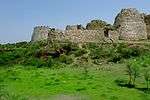
- 🌍 Tughlaqabad Fort, Delhi. A massive fort in Delhi built by Ghiyasuddin Tughlaq as the third city of Delhi and later abandoned. All that remains are it huge ruins.
- 🌍 Visapur Fort (Visapoor Fort) (near Visapur Village). The history of Visapur fort is closely related to that of the Lohagad Fort and their history together is closely related. Very little remains of Visapur fort; however, Lohagad fort is still standing.
- 🌍 Warangal Fort, Warangal. This fort is home to four gates (Warangal Gates) formerly to an important Shiva temple. Many "wall slabs and panels" are displayed outdoors. What remains is listed as a Monument of National Importance.
Palaces

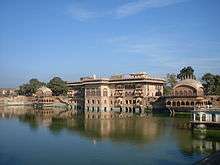
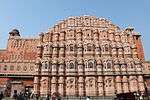
- 🌍 Amar Mahal Palace, Jammu. Now a popular museum; the red sandstone Amar Mahal Palace can be found in the scenic area of Jammu.
- 🌍 City Palace, Jaipur. This large palace complex was built by Maharaja Jai Singh II in a combination of Rajput and Mughal styles. It consists of many buildings, courtyards and gardens.
- 🌍 Cooch Behar Palace (Victor Jubilee Palace), Cooch Behar. This is a double storied palace (based upon the layout of the Buckinham Palace) was built in the time of Maharaja Nripendra Narayan. Most of the precious artifacts that occupied the palace have been lost or removed
- 🌍 Deeg Palace (Jal Mahal), Bharatpur. Deeg Palace was built for Bharatpur rulers as a summer retreat.
- 🌍 Gajner Palace, Bikaner. Built on a lake (Bikaner) embankment by H.H. Maharaja Sir Ganga Singhji. It is located in the Gajner Wildlife Sanctuary and was used my British and Indian elite as a hunting retreat. Currently the palace is a Heritage Hotel.
- 🌍 Garh Palace (Bundi Palace), Bundi. This palace was built next to Taragarh Fort on a hill. It contains many fescoes and murals.
- 🌍 Hawa Mahal (Palace of the Winds), Jaipur. Built as an extension of the women's (Zenana) chamber to the City Palace in red sandstone. Its many stories with windows allow a breeze (Hawa) to circulate within.
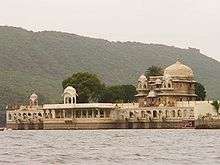
- 🌍 Jagmandir (Jag Mandir and Lake Garden Palace), Lake Pichal, Udaipur. Jag Mandir was built on an island. This is the main palace on Lake Pichola. Other smaller palaces and gardens are to be found here. This palace was converted into a hotel.
- 🌍 Jahangiri Palace (Jahangiri Mahal). this palace was built by Emperor Akbar for the women of his household and his wives. It is located with the well know Agra Fort.
- 🌍 Jal Mahal (Water Palace), Jaipur. On Man Sagar Lake, the King of Amber built the wonderful Jal Mahal.
- 🌍 Juna Mahal, Dungarpur, Rajasthan. Once adorned with mirror and glass inlays, murals and frescoes, this royal residence near the Thar desert has deteriorated and been vandalized.
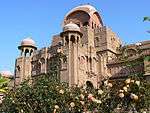
- 🌍 Lalgarh Palace, Bikaner. This palace was built because the nearby Junagarh Palace did not meet the standards for a modern monarch. It has impressive intricate and detailed workmanship. Areas (wings) of the palace were converted to hotels. (one became a heritage hotel).
- 🌍 Lake Palace, Lake Pichal, Udaipur. Built on a lake, this palace has several courtyards, fountains and terraced gardens.
- 🌍 Monsoon Palace (Sajjan Garh Palace,), Udaipur. Under the control of the Forestry Department, this palace offers astounding views of the surrounding area. It is usually illuminated at night and is a fantastic site.
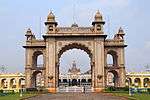
- 🌍 Mysore Palace (Maharaja's Palace), Mysore. This royal palace offers carved doors, inlaid ivory, paintings, marble figures and contains many personal objects of the royal family on display.
- 🌍 Naulakha Palace, Gondal, Gujarat. A very old palace found within Darbargardh Fort. It has many carved structural features and contains a private museum.
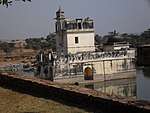
- 🌍 Padmini's Palace (Queen's Palace), Chittorgarh. A reconstructed palace located in Chittorgarh Fort. History and many stories (legends) are associated with this moated palace.
- 🌍 Pragmalji Palace (Prag Mahal), Bhuj, Gujarat. Noted palace of Kutch regional rulers. It was built in Gothic (Indo-Gothic) style.
- 🌍 Rambagh Palace, Jaipur. This palace had humble beginnings as a garden house (1800s). It was enlarged with many royal gardens and suites. It has been converted into a hotel.
- 🌍 Udaipur City Palace (Udai Bilas Palace), Udaipur. In reality, this is a complex of many palaces (large and small), museums and splendid gardens. There is a view of Lake Pichal from this location. Splendid mosaics, murals, inlays etc. are to be found here as well.

- 🌍 Umain Bhawan Palace (Umaid Bhavan Palace), Jodhpur. A large grand private residence Chittar Palace has a museum and part is managed as a hotel.
- 🌍 Vinay Vilas Mahal, Alwar. This palace complex is located below Bala Quila Fort. There is a wonderful garden and many murals etc. Sections of this palace were altered into government offices. A nearby city museum has a collection of miniature paintings and manuscripts.
- note: The symbol
